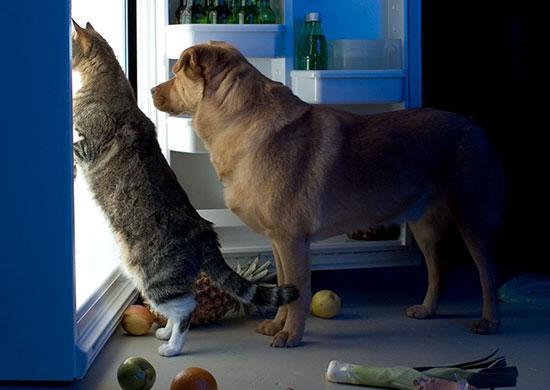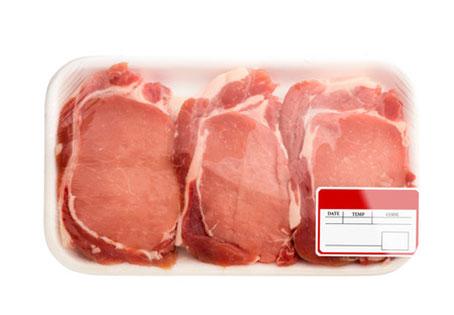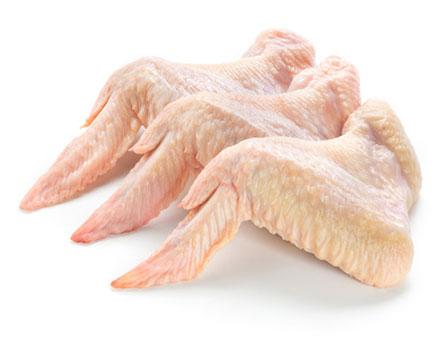This content is archived from the Feline Nutrition Foundation
Safe Handling Practices for Raw Meat
- Updated: Saturday, June 01, 2019 03:00 PM
- Published: Tuesday, June 01, 2010 12:29 PM
- Written by Pat Puckett
 One of the major concerns of people feeding a raw diet is safe food handling to protect the human family and our companion animals. Knowing the difference between spoilage and pathogenic bacteria as well as following temperature and time guidelines makes our decision to feed a raw diet easier. Much of the information provided in this article is directed at human safety – a standard also used by many people when feeding their companion animals. This information is from the Food Safety and Inspection Service of the USDA and other sites that rely on USDA and FDA guidelines.
One of the major concerns of people feeding a raw diet is safe food handling to protect the human family and our companion animals. Knowing the difference between spoilage and pathogenic bacteria as well as following temperature and time guidelines makes our decision to feed a raw diet easier. Much of the information provided in this article is directed at human safety – a standard also used by many people when feeding their companion animals. This information is from the Food Safety and Inspection Service of the USDA and other sites that rely on USDA and FDA guidelines.
Sources of contamination are almost as numerous and varied as the contaminants themselves. Bacteria and other infectious organisms are pervasive in the environment. Salmonella enters eggs directly from the hen. Bacteria, occasionally pathogenic, inhabit the surfaces of fruits and vegetables in the field. Molds and their toxic byproducts can develop in grains during unusually wet or dry growing seasons, damage and stress during harvesting or during improper storage. Seafood may become contaminated from agricultural and other runoff, as well as by sewage, microorganisms and toxins present in marine environments.
Many organisms that cause food-borne illness in humans can be part of the normal flora of the gastrointestinal tract of food-producing animals without any adverse effects to the animal. Milk, eggs, seafood, poultry and meat from food-producing animals may become contaminated through contaminated feed, misuse of veterinary drugs or poor farming practices. This includes production and harvesting activities, or disposal of solid waste on land.
Foods may become contaminated during processing through:
- malfunctioning or improperly sanitized equipment,
- misuse of cleaning materials,
- rodent and insect infestations, and
- improper storage.
 Foods may become contaminated in retail facilities and in the home through use of poor food-handling practices, including time and temperature abuse and cross-contamination from other foods.
Foods may become contaminated in retail facilities and in the home through use of poor food-handling practices, including time and temperature abuse and cross-contamination from other foods.
Spoilage bacteria are microorganisms too small to be seen without a microscope. They cause food to deteriorate and develop unpleasant odors, tastes and textures. These one-celled microorganisms can cause fruits and vegetables to get mushy and slimy or meat to develop a bad odor.¹
There are different spoilage bacteria and each reproduces at specific temperatures. Some can grow at the low temperatures in a refrigerator or freezer. Others grow well at room temperature and in the "Danger Zone" – temperatures between 40 and 140°F. Bacteria will grow anywhere they have access to nutrients and water. Under the correct conditions, spoilage bacteria reproduce rapidly. In some cases they can double their numbers in as little as 20 minutes.²
Pathogenic bacteria can cause illness in humans and possibly in pets that are already ill. They grow rapidly in the Danger Zone and do not generally affect the taste, smell or appearance. Food that is left too long at unsafe temperatures can be dangerous to eat but smell and look just fine. E. coli O157:H7, campylobacter, listeria and salmonella are examples of pathogenic bacteria. These bacteria are sometimes already present when purchased or are introduced through cross-contamination.³
Food constantly stored at 0°F will always be safe unless pathogenic bacteria are already present. Only the quality suffers with lengthy freezer storage. Freezing keeps it safe by slowing the movement of molecules, causing microbes to enter a dormant stage. Freezing preserves food for extended periods because it prevents the growth of microorganisms that cause both spoilage and food-borne illness. Freezing to 0°F inactivates any microbes – bacteria, yeasts and molds – present in food. Once thawed, however, these microbes can again become active, multiplying under the right conditions to levels that can lead to food-borne illness. As they will then grow at about the same rate as microorganisms on fresh food, you must handle thawed items as you would any perishable food. Thawing products only to the extent that allows for separation into smaller quantities to be re-frozen is safe. Once the product reaches 40°F, however, bacteria will grow. Water lost in the thawing process will result in less moisture in the product, so it is important to re-freeze promptly to retain quality. Do not confuse the moisture in the product with any ice formed in freezing.
Freshness and quality at the time of freezing affect the condition of frozen foods. If frozen at peak quality, foods taste better than foods frozen near the end of their useful life. So, freeze items you won't use quickly sooner rather than later. Store all foods at 0°F or lower to retain vitamin content, color, flavor and texture.
The freezing process itself does not destroy nutrients. In meat and poultry products, there are little changes in nutrient value during freezer storage. But enzyme activity can lead to the deterioration of food quality. Enzymes present in animals, vegetables and fruit promote chemical reactions, such as ripening. Freezing only slows the enzyme activity – it does not halt these reactions which continue after harvesting. Enzyme activity does not harm frozen meats or fish.⁴

Freezer burn does not make food unsafe, merely dry in spots. It appears as grayish-brown leathery spots and is caused by air reaching the surface of the food. You can cut freezer-burned portions away. Some may discard heavily freezer-burned foods for quality reasons.
Color changes can occur in frozen foods. The bright red color of meat as purchased usually turns dark or pale brown depending on its variety. This may be caused by lack of oxygen, freezer burn or abnormally long storage. Freezing doesn't usually cause color changes in poultry. However, the bones and meat near them can become dark. Bone darkening results when pigment seeps through the porous bones of young poultry into the surrounding tissues when the meat is frozen and thawed.⁵
Because freezing keeps food safe almost indefinitely, recommended storage times are for quality only. Many freezing charts are available. Cryo-vac packaging can also extend the freezing life of products and is often not addressed in these charts.
Never defrost foods in a garage, basement, car, dishwasher, plastic garbage bag, outdoors or on the porch. Do not leave food defrosting on the kitchen counter. These methods can leave your foods unsafe to eat. Flies and other pests pose potential contamination threats. Ambient temperatures can cause rapid thawing, moving the product quickly into the Danger Zone.
 There are two safe ways to defrost food: in the refrigerator or in cold water. It's best to plan ahead for slow, safe thawing in the refrigerator. Small items may defrost overnight; most foods require a day or two. Large items like turkeys may take longer, approximately one day for each 5 pounds of weight.
There are two safe ways to defrost food: in the refrigerator or in cold water. It's best to plan ahead for slow, safe thawing in the refrigerator. Small items may defrost overnight; most foods require a day or two. Large items like turkeys may take longer, approximately one day for each 5 pounds of weight.
For faster defrosting, place food in a leak proof plastic bag and immerse it in cold water. If the bag leaks, bacteria from the air or surrounding environment could be introduced into the food. Tissues can also absorb water like a sponge, resulting in a watery product. Check the water frequently to be sure it stays cold. Change the water every 30 minutes. After thawing, serve and refrigerate any leftover product immediately.⁶
Microwave-defrosting food is not recommended because some areas of the food may become warm and begin to cook. Never cook bones that will be served to companion animals. They will become brittle and dangerous as well as losing most of their nutrient value.⁷
Additional Reading
Salmonella: The Chicken or the Egg
Spooked By Salmonella: Raw Cat Food!
To determine the safety of foods when the power has been interrupted, check their condition and temperature. If food is partly frozen, still has ice crystals or is as cold as if it were in a refrigerator (40°F), it is safe to refreeze or use. It's not necessary to cook raw foods before refreezing. Avoid foods that have been warmer than 40°F for more than two hours or have been contaminated by raw meat/poultry juices.
Recommended reading for more information and reference:
USDA Common Questions About Food Safety
Pat Puckett is the founder of the SoCalBARF Buyer's Group, one of the largest in the US. An educational group interested in fostering and promoting the health of companion animals through raw diets, they accept all forms of raw feeding as chosen by their members. Besides providing bulk raw meat purchasing to their members, they offer educational seminars on animal health and nutrition.
1. "Fundamental Food Microbiology," USDA Publication, June 2014.
2. "General Hygiene Principles for Meat Handling, " Food and Agriculture Organization of the United Nations.
3. "Be Smart, Keep Foods Apart," U.S. Department of Agriculture Food Safety and Inspection Service.
4. "Freezing and Food Safety," U.S. Department of Agriculture Food Safety and Inspection Service.
5. "The Color of Meat and Poultry," U.S. Department of Agriculture Food Safety and Inspection Service.
6. "The Big Thaw – Safe Defrosting Methods for Consumers," U.S. Department of Agriculture Food Safety and Inspection Service.
7. Dr. Bruce Syme, BVSc (Hons), "Feeding Raw Bones to Cats and Dogs."




